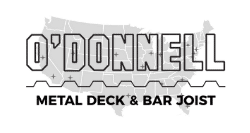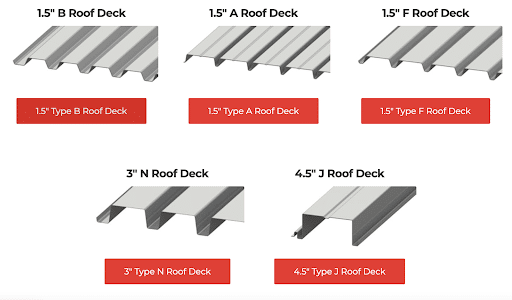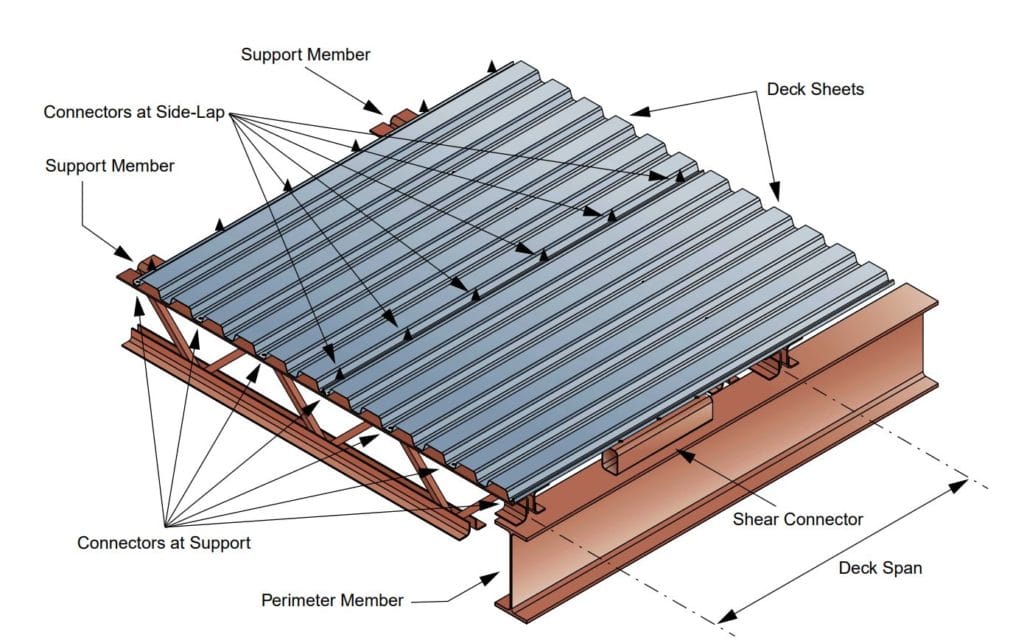The construction industry has been transformed by metal roof decking. It is essential in ensuring that buildings are structurally sound, safe and efficient. In this article, we will discuss metal roof decking, its uses and the five types available from O’Donnell Metal Deck. We will also discuss gauges and coatings, which are essential factors in determining the performance and durability of metal roof decks.
What is Metal Roof Decking?
Metal roof decking is a type of steel component used in commercial and industrial buildings as a strong base for roofing systems. Metal roof decks support the weight of the roofing materials, and distribute imposed loads like wind, snow and other environmental factors while aiding in the building’s structural stability and rigidity. They also support personnel and equipment during construction.
Primary Types of Metal Roof Decking Offered by O’Donnell Metal Deck
O’Donnell Metal Deck is a leading provider of metal roof decking solutions. They offer five types of metal roof decks, each with its unique features, applications and advantages. However, the most common roof decking profiles are Type B and Type N.
- Type B Deck
- Type N Deck
Type B Deck:
Type B Deck, also known as wide rib deck, is known for its wide rib profile and enhanced load-bearing capacity. It is often used in commercial and industrial buildings where greater structural support is needed. Type B Deck can be applied in both insulated and non-insulated roofing systems, which makes it a versatile option.
- Typical Span Width (depending on gauge): 4-8’
- Coverage width: 36 inches
- Panel thickness: 1.5 inches
- Standard panel length: 20 feet 2 inches, 24 feet 6 inches, 25 feet 2 inches and custom
- Gauges: 16, 18, 20 and 22 gauge
- Coatings: G-60, G-90 and PTD
Type N Deck:
Type N Deck, or deep rib deck, is designed for use in projects that require greater spans between supports. Its unique profile provides additional strength and rigidity, which makes it an ideal choice for large-scale commercial and industrial applications with wide column spacing.
- Typical Span Width (depending on gauge): 7-13’
- Coverage width: 24 inches
- Panel thickness: 3 inches
- Standard panel length: 24 feet 2 inches, 30 feet 6 inches and custom
- Gauges: 18, 20 and 22 gauge
- Coatings: G-60, G-90 and PT
Less Common Roof Deck Profiles-Specialty Applications
(A&F Deck are Older Profiles and J Deck is for Unique Long-Span Conditions)
Type A Deck:
Type A Deck is characterized by its narrow rib profile, which is a lightweight yet strong and sturdy solution for commercial and industrial buildings. This decking type is ideal for use in structures that require a lighter load-bearing capacity and is often used in roofing applications where insulation is not required.
- Typical Span (depending on gauge): 3’-10” – 6’11
- Coverage width: 36 inches
- Panel thickness: 1.5 inches
- Standard panel length: 25 feet 2 inches and custom
- Gauges: 18, 20 and 22 gauge
- Coatings: G-60, G-90 and PTD
Type F Deck:
Type F Deck is also referred to as an intermediate rib deck and is often used for repair and re-roofing jobs. This design allows for better load distribution and improved structural stability. Type F Deck is suitable for applications where a combination of insulation and load-bearing capacity is required but is not often used for new construction projects. Type B Deck is the most popular metal roof deck for this application.
- Typical Span (depending on gauge): 4’-6” – 6’3”
- Coverage width: 36 inches
- Panel thickness: 1.5 inches
- Standard panel length: 20 feet 2 inches and custom
- Gauges: 18, 20 and 22 gauge
- Coatings: G-60, G-90 and PTD
Type J Deck:
Type J Deck is utilized for spans that go beyond the limits of the Type “N” deck. It can span greater distances between supports and support heavier loads because it has a profile depth of 4.5 inches. It is also available as acoustical decking and cellular decking.
- Typical Span (depending on gauge): 15’-20’
- Coverage width: 12 inches
- Panel thickness: 6 inches
- Standard panel length: Custom
- Gauges: 16, 18, 20 and 22 gauge
- Coatings: G-60, G-90 and PTD
Understanding Gauges and Coatings
Gauge
The gauge number of steel is an indicator of its thickness — lower gauge numbers correspond to thicker steel and higher gauge numbers mean thinner steel.
Coatings
To protect metal roof decking from corrosion, increase its lifespan and improve its appearance, coatings are necessary. The industry commonly uses coatings such as:
- G-60: The deck industry typically uses Galvanized G-60 zinc-coated steel as the standard. G60 metal deck has about 0.6 ounces of zinc per square foot.
- G-90: G90 metal deck has 0.9 ounces per square foot. It is more often used on projects in corrosive environments, such as near the sea.
- PTD: The term “PTD” or “primer painted” refers to a temporary coating that is colored gray on both sides.
O’Donnell Metal Decks is a Premium Metal Roof Deck Supplier
If you’re considering metal roof decking for your commercial or industrial project, O’Donnell Metal Deck is your source for high-quality, reliable and durable solutions. With our extensive range of metal roof decking types, we can meet the unique requirements of any project.
Our experienced team of professionals is always ready to provide guidance on selecting the right type, gauge and coating based on your project’s specific needs. We also carry steel form deck and composite steel deck products, as well as the accessories to complete the project.
Contact us today to learn more about our products!








